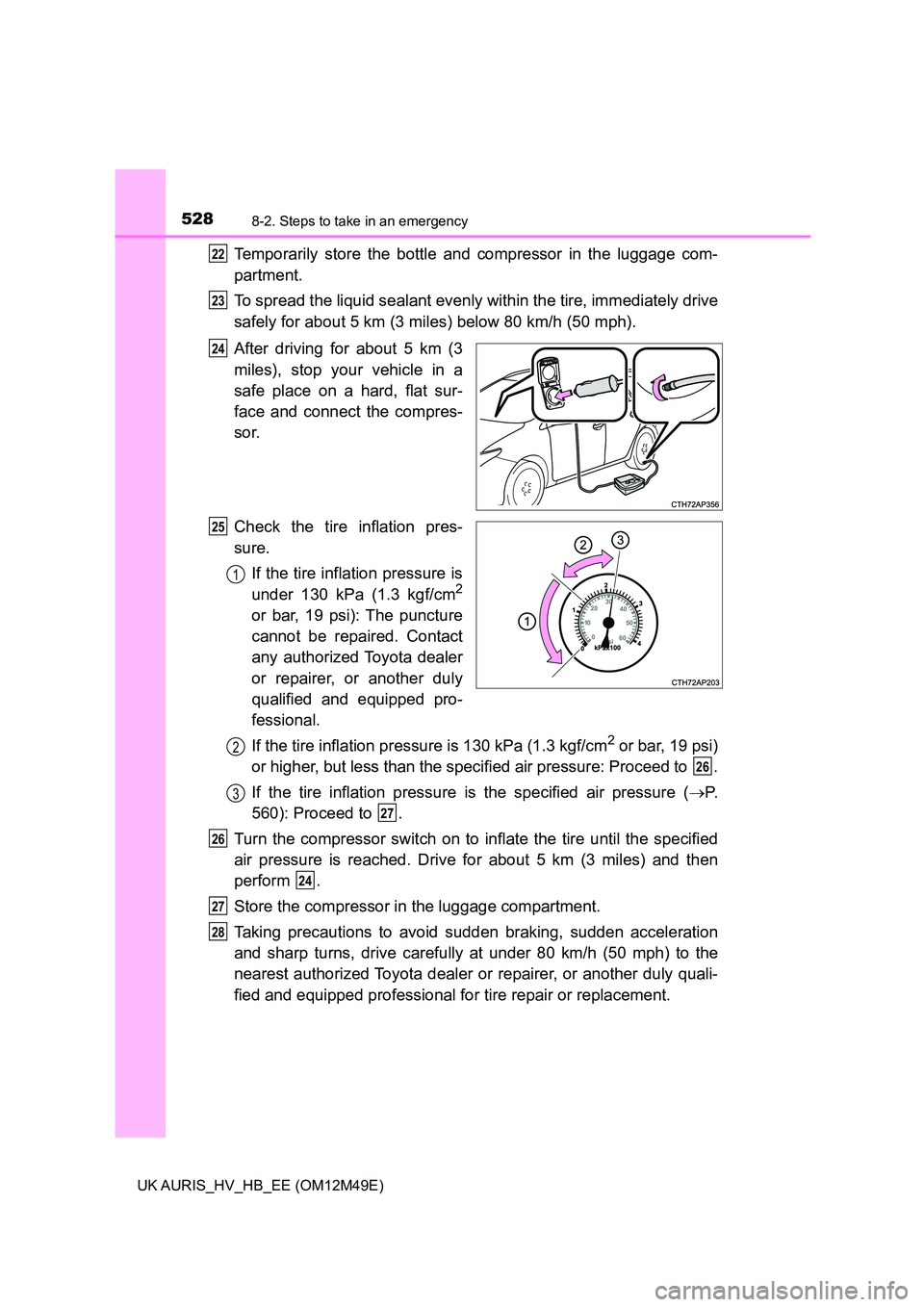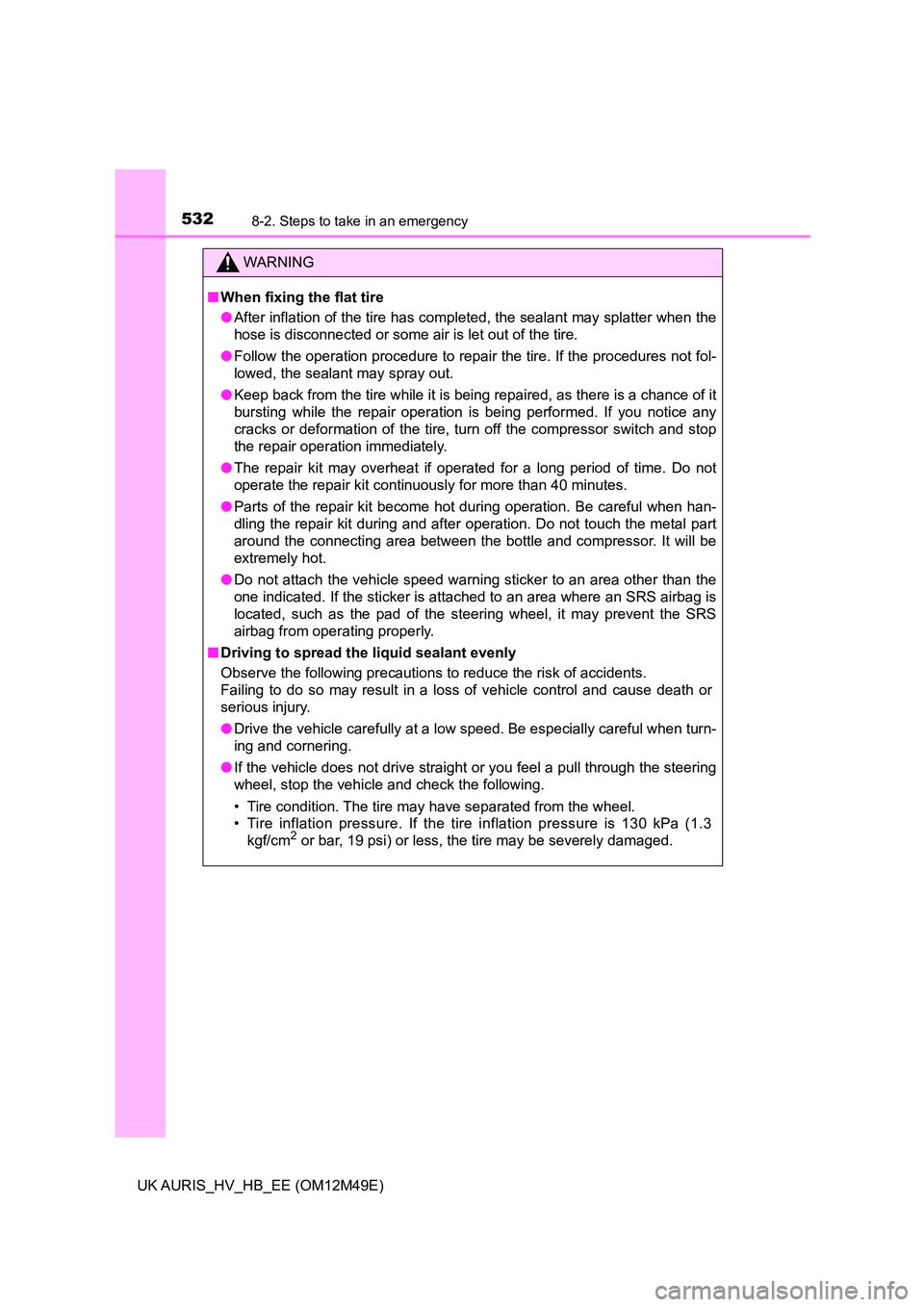Page 525 of 592
5258-2. Steps to take in an emergency
UK AURIS_HV_HB_EE (OM12M49E)
8
When trouble arises
Make sure that the compressor
switch is off.
Remove the power plug from
the compressor.
Connect the power plug to the
power outlet socket. ( P. 407)
Check the specified tire inflation pressure.
Tire inflation pressure is specified on the label as shown. ( P. 560)
9
10
11
12
Left-hand drive vehiclesRight-hand drive vehicles
Page 526 of 592
5268-2. Steps to take in an emergency
UK AURIS_HV_HB_EE (OM12M49E)
Start the hybrid system.
To inject the sealant and inflate
the tire, turn the compressor
switch on.
Inflate the tire until the specified
air pressure is reached.
The sealant will be injected
and the pressure will surge
and then gradually decrease.
The air pressure gauge will
display the actual tire infla-
tion pressure about 1 minute
(5 minutes at low tempera-
ture) after the switch is
turned on.
Inflate the tire until the speci-
fied air pressure.
• If the tire inflation pressure is
still lower than the specified
point after inflation for 35 min-
utes with the switch on, the tire
is too damaged to be repaired.
Turn the compressor switch off
and contact any authorized
Toyota dealer or repairer, or
another duly qualified and
equipped professional.
• If the tire inflation pressure exceeds the specified air pressure, let out
some air to adjust the tire inflation pressure. ( P. 529, 560)
13
14
15
1
2
3
Page 528 of 592

5288-2. Steps to take in an emergency
UK AURIS_HV_HB_EE (OM12M49E)
Temporarily store the bottle and compressor in the luggage com-
partment.
To spread the liquid sealant evenly within the tire, immediately drive
safely for about 5 km (3 miles) below 80 km/h (50 mph).
After driving for about 5 km (3
miles), stop your vehicle in a
safe place on a hard, flat sur-
face and connect the compres-
sor.
Check the tire inflation pres-
sure.
If the tire inflation pressure is
under 130 kPa (1.3 kgf/cm2
or bar, 19 psi): The puncture
cannot be repaired. Contact
any authorized Toyota dealer
or repairer, or another duly
qualified and equipped pro-
fessional.
If the tire inflation pressure is 130 kPa (1.3 kgf/cm2 or bar, 19 psi)
or higher, but less than the specified air pressure: Proceed to .
If the tire inflation pressure is the specified air pressure (P.
560): Proceed to .
Turn the compressor switch on to in flate the tire until the specified
air pressure is reached. Drive for about 5 km (3 miles) and then
perform .
Store the compressor in the luggage compartment.
Taking precautions to avoid s udden braking, sudden acceleration
and sharp turns, drive carefully at under 80 km/h (50 mph) to the
nearest authorized Toyota dealer or repairer, or another duly quali-
fied and equipped professional fo r tire repair or replacement.
22
23
24
25
1
2
26
3
27
26
24
27
28
Page 529 of 592
5298-2. Steps to take in an emergency
UK AURIS_HV_HB_EE (OM12M49E)
8
When trouble arises
■If the tire is inflated to more than the specified air pressure
Check that the air pressure indicator shows the specified air pressure.
If the air pressure is under the designated pressure, turn the compressor
switch on again and repeat the inflation procedure until the specified air
pressure is reached.
■ After a tire is repaired with the emergency tire puncture repair kit
● The tire pressure warning valve and transmitter should be replaced.
● Even if the tire inflation pressure is at the recommended level, the tire pres-
sure warning light may come on/flash.
Press the button to let some air out.1
2
Page 532 of 592

5328-2. Steps to take in an emergency
UK AURIS_HV_HB_EE (OM12M49E)
WARNING
■When fixing the flat tire
● After inflation of the tire has completed, the sealant may splatter when the
hose is disconnected or some air is let out of the tire.
● Follow the operation procedure to repair the tire. If the procedures not fol-
lowed, the sealant may spray out.
● Keep back from the tire while it is being repaired, as there is a chance of it
bursting while the repair operation is being performed. If you notice any
cracks or deformation of the tire, turn off the compressor switch and stop
the repair operation immediately.
● The repair kit may overheat if operated for a long period of time. Do not
operate the repair kit continuously for more than 40 minutes.
● Parts of the repair kit become hot during operation. Be careful when han-
dling the repair kit during and after operation. Do not touch the metal part
around the connecting area between the bottle and compressor. It will be
extremely hot.
● Do not attach the vehicle speed warning sticker to an area other than the
one indicated. If the sticker is attached to an area where an SRS airbag is
located, such as the pad of the steering wheel, it may prevent the SRS
airbag from operating properly.
■ Driving to spread the liquid sealant evenly
Observe the following precautions to reduce the risk of accidents.
Failing to do so may result in a loss of vehicle control and cause death or
serious injury.
● Drive the vehicle carefully at a low speed. Be especially careful when turn-
ing and cornering.
● If the vehicle does not drive straight or you feel a pull through the steering
wheel, stop the vehicle and check the following.
• Tire condition. The tire may have separated from the wheel.
• Tire inflation pressure. If the tire inflation pressure is 130 kPa (1.3
kgf/cm2 or bar, 19 psi) or less, the tire may be severely damaged.
Page 560 of 592
5609-1. Specifications
UK AURIS_HV_HB_EE (OM12M49E)
15-inch tires
*: The tire inflation pressure is specified on the tire-loading information label.
(P. 453)
Tires and wheels
Tire size195/65R15 91H
Tire inflation pres-
sure
(Recommended
cold tire inflation
pressure)
Vehicle speed
Front wheel
kPa (kgf/cm2
or bar, psi)
Rear wheel
kPa (kgf/cm2
or bar, psi)
More than 160
km/h (100 mph)
Type A*:
260 (2.6, 38)
Type B*:
270 (2.7, 39)
Type A*:
260 (2.6, 38)
Type B*:
270 (2.7, 39)
160 km/h (100
mph) or less
Type A*:
230 (2.3, 33)
Type B*:
240 (2.4, 35)
Type A*:
230 (2.3, 33)
Type B*:
240 (2.4, 35)
Wheel size15 6 J
Wheel nut torque103 N•m (10.5 kgf•m, 76 ft•lbf)
Page 561 of 592
5619-1. Specifications
UK AURIS_HV_HB_EE (OM12M49E)
9
Vehicle specifications
16-inch tires
*1: For optimizing fuel economy, ECO tire pressure is recommended. Tire
pressure affects traveling comfort, road noise and steering characteristics.
*2: Vehicles with ECO tire pressure label (P. 453)
Tire size205/55R16 91V
Tire inflation pres-
sure
(Recommended
cold tire inflation
pressure)
Vehicle speed
Front wheel
kPa (kgf/cm2
or bar, psi)
Rear wheel
kPa (kgf/cm2
or bar, psi)
More than 160
km/h (100 mph)260 (2.6, 38)260 (2.6, 38)
Normal pressure:
160 km/h (100
mph) or less
230 (2.3, 33)230 (2.3, 33)
ECO pressure*1:
160 km/h (100
mph) or less
250 (2.5, 36)*2250 (2.5, 36)*2
Wheel size16 6 1/2 J
Wheel nut torque103 N•m (10.5 kgf•m, 76 ft•lbf)
Page 562 of 592
5629-1. Specifications
UK AURIS_HV_HB_EE (OM12M49E)
17-inch tires
Compact spare tire
■When towing a trailer
Add 20.0 kPa (0.2 kgf/cm2 or bar, 3 psi) to the recommended tire inflation
pressure and drive at speeds below 100 km/h (62 mph).
Tire size225/45R17 91W
Tire inflation pres-
sure
(Recommended
cold tire inflation
pressure)
Vehicle speed
Front wheel
kPa (kgf/cm2
or bar, psi)
Rear wheel
kPa (kgf/cm2
or bar, psi)
More than 160
km/h (100 mph)260 (2.6, 38)260 (2.6, 38)
160 km/h (100
mph) or less230 (2.3, 33)230 (2.3, 33)
Wheel size17 7 J
Wheel nut torque103 N•m (10.5 kgf•m, 76 ft•lbf)
Tire sizeT125/70D17 98M
Tire inflation pressure
(Recommended cold
tire inflation pressure)
420 kPa (4.2 kgf/cm2 or bar, 60 psi)
Wheel size17 4 T
Wheel nut torque103 N•m (10.5 kgf•m, 76 ft•lbf)